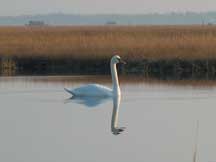| |

April 2004, Vol. 13, No. 4 | Return to Table of Contents
Plum Island Sound Projects Link Science to Local Community
As the pressures of human population and land development increase and the threat of global warming and rising sea level looms, coastal communities around the nation are all facing the same problem. How do they resolve issues like housing growth and the proper discharge of sewage effluent yet preserve the delicate habitat around them?
There are no easy answers, and while it's true that science will provide the basis for making these decisions, once researchers identify the causes, deciding what to do (if anything) will be a societal decision.
MBL Senior Scientist Linda Deegan and her colleagues at The Ecosystems Center realize that the fate of our country's coastal ecosystems relies upon the cooperation of scientists, policy makers, land managers, and citizens. Her research project based in the Plum Island Sound region of Massachusetts'; North Shore is a testament to that belief.
 |
|
Deegan, an aquatic ecologist, along with colleagues from the MBL and four other institutions from around the nation, is studying how salt marshes in the area are affected by nutrient inputs from upland activities, including development. Their large-scale project (named TIDE for Trophic cascades and Interacting control processes in a Detritus-based aquatic Ecosystem), involves enriching tidal creeks with nutrients to mimic nutrient overloading, and altering the population of a key salt marsh fish species, the mummichog, to better understand how these multiple stresses may affect the sustainability of coastal ecosystems. "This project is the first of its kind in the world and has the potential to fundamentally change how we think about coastal ecosystems," said Deegan. "We have always thought that salt marshes could tolerate nutrient enrichment better than other habitats. However, when we alter nutrients and the natural community at the same time, salt marshes may incur more damage than we initially thought."
Deegan's work is just one part of the National Science Foundation-funded Plum Island Estuary Long-Term Ecological Research Program (PIE-LTER), based on the North Shore. Plum Island Sound sits in the center of 20,000 acres of salt marsh that lie between Cape Ann and the New Hampshire border. Ecosystems Center scientists have been studying the embayment and marshes here since the mid 1980s. In 2003, the MBL purchased a five-acre farm in the North Shore community of Newbury to enable the expansion of Plum Island Sound research that focuses on understanding how coastal ecosystems are affected by changing land cover, climate, and sea level.
While one of the goals of the PIE-LTER is to contribute scientific information that will help coastal communities nationwide, the information gleaned from the TIDE project and other PIE-LTER projects will be particularly beneficial to policy-makers in towns like Ipswich, Massachusetts, who view the research as providing the scientific basis of their future management decisions.
"With the development and approval of the MBL's TIDE project on the Great Marsh, the Ipswich Conservation Commission has taken a particular interest in the research conducted by MBL scientists in the Plum Island Estuary. The Ipswich Conservation Commission has not only granted permission for the project to proceed as proposed, but also recognizes the importance the research findings will have for future town management decisions," said Ipswich Conservation Commission Agent, David Pancoast, Esq. "The continued collaboration with Marine Biological Laboratory research in the Plum Island Sound region will enhance the outreach and education potential of this Conservation Commission and improve our ability to make informed decisions regarding resource management."
Community connections have and will continue to play an important role in PIE-LTER research. Deegan and colleague Chuck Hopkinson, MBL Senior Scientist and lead principal investigator of the PIE-LTER, have established partnerships with local, state, and federal agencies, conservation organizations, schools, and citizens who use their research results to better manage local resources. From working with citizen volunteers to develop a water monitoring program, to helping the Town of Ipswich evaluate the impacts of their sewage effluent on the environment, to providing a hands-on field experience for school children, the PIE-LTER has taken an active role in educating local stakeholders, young and old, about what their scientific findings may mean to the local community. "What started out as a "minimalist program" has grown to be a broad, well-rounded suite of activities," said Hopkinson. "Our long-term goal is to establish an outreach office at our study site that would serve to integrate and promote our interactions with interested parties throughout New England."
|